
|
<<Back |
Budapest,
Hungary
Nov.
26 - Dec. 5, 2010 |
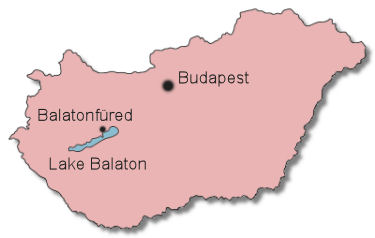
|
|
|
| Faced with three family
milestone birthdays and a possible wedding in 2011, we
were pressed to use our timeshare exchange before the
end of the year. Project deadlines at J’s work brought
us into November before we could get away. The exchange
options were fairly limited, and since neither of us
felt we were remotely close to “beach shape”, we looked
for something attuned to the time of year. We managed an
exchange with a resort hotel in the Transdanubian region
near Budapest that looked like it would allow for
convenient day trips to visit this great European
capital city.
|
|
|
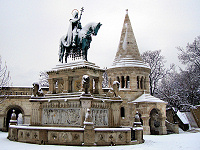
King Stephen of Hungary
|
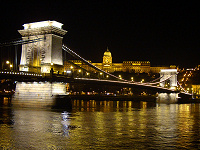
Chain Bridge and the Royal Palace
|

The Roman ruins at Aquinicum
|
|
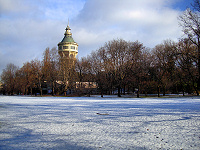
Margaret Island
|
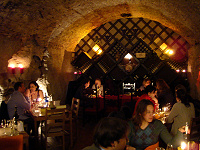
Royal wine cellar in Buda Castle
|
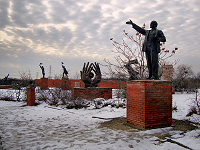
A bygone era at Momento Park
|
|
|
Budapest was formed by the
joining of the cities of Buda and Pest, but
what was surprising to us was that this only
happened about 150 years ago. In fact, the first
permanent bridge connecting the two towns, the Chain
Bridge, also dates back to this time. Our
introduction to Buda came in the form of a room at
the Hilton with a beautiful view of the Danube. It’s
amazing what a Hilton Honors membership and $50
bucks can do. OK, it was probably the $50 that had
the most influence. Situated on the Buda Castle
complex, the hotel was built by incorporating the
ruins of a Dominican church. The adjacent Mátyás
church, Fisherman’s Bastion, and royal palace
dominate the skyline on the west bank of the Danube.
The strategic aspects of this hill have not gone
unnoticed. Magyars, Bulgars, French, Turks, and the
Habsburgs have all had a hand in its development
since the 13th century. At one point, the royal
palace had more than 200 rooms. It has since been
destroyed and rebuilt several times over the years,
and since the end of World War II, appears as it did
in the 19th century
We wound our way down the staircases leading down
to the river and eventually to the hill south of the
Castle District. Gellért Hill is named for the
Italian bishop who was martyred there in 1046 by
pagans who sealed him in a barrel and threw him down
the hill. We stopped in the ornate Hotel Gellért at
the base of the hill for our first taste of goulash
and then walked up to the top for some dazzling views of the
city bisected by the Danube. While the hill is now a
public park, it is crowned by a citadel built by the
Austrian Habsburgs in 1851 to make it clear to the
city’s inhabitants who was in charge. Staying with
the same theme, a towering monument now stands in
front of the citadel to commemorate the Soviet
liberation of Budapest from German occupation in
1945 – a transition from one master to another.
We woke the next
morning to a city blanketed with snow – as if
powdered sugar had been sprinkled on the rooftops
overnight. We decided to walk off a killer breakfast
buffet by taking a stroll on Margaret Island. Long
used as hunting grounds, site of religious
contemplation, and even home to a Turkish harem when
the Ottomans were in charge, the island is named for
the daughter of King Bela IV because she was sent to
a convent there at the age of nine. Princess
Margaret was the bargaining chip in an oath Bela
made to God in exchange for divine assistance in
fending off the Mongols in 1241. Today the island is
a place of leisure featuring pools, paths, and parks.
We were looking
for something to do one evening, and we had read
about wine tastings that took place in the royal
wine cellar deep in the foundations of the castle.
We had about an hour to kill before dinner so this
seemed as good a time as any to try it out. The
Faust cellar is as quaint and romantic a place as
you would want to sample wine from the region. Wine
was introduced to Hungary by the Romans, and there
are now over 20 wine making regions including the
Lake Balaton area. For about 20 euros each, we were
able to choose six wines to sample in addition to
some small snacks to clean the palate. The sommelier
provided extensive background on each wine with
colorful descriptions of the notes we were expected
to detect such as black currant, honeydew, and fresh
cut grass. The only problem was that we each chose
six different wines and the sommelier also served
the other handful of tables in the cellar, so after
about 45 minutes, we were only into our second
tasting. We knew we were in trouble. Our dinner plans
would obviously be delayed, and we cleared the
plates of snacks almost before they hit the table.
So two and a half hours later, we were presented
with a complimentary glass of Tokaji dessert wine
which we drank in one shot (to the disgust of our
host) and scurried to the exit in the hope that we
could still find a restaurant that would serve us.
One site we didn’t want to
miss was Memento Park on the outskirts of Budapest.
After the fall of communism, streets and squares
were renamed, Soviet murals painted over, and
statues toppled. While little of that era remains
today, some of the statues have been put on display
at this park. A barracks-style building houses a
museum dedicated to the Hungarian revolution of 1956
when protesting students demanded political reform
and freedom. They initiated a movement which
culminated in a new government
that advocated secession from the Warsaw Pact and
demanded the withdrawal of all Soviet troops. After
weeks of anticipation, the uprising came to an end
when the USSR sent Red Army soldiers to Budapest to
retake the city and re-install a communist
government. It is estimated that more than 20,000
Hungarians died in the revolution.
|
|
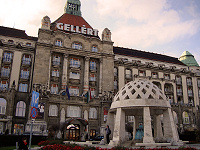
Hotel Gellért
|
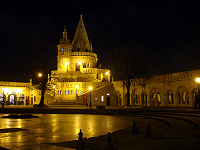
Fisherman's Bastion
|
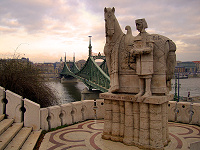
St. Stephen and the Liberty
Bridge.
|
|

St. Matthias Cathedral
|
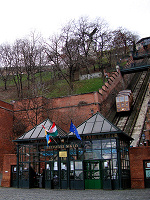
Funicular to Buda Castle
|
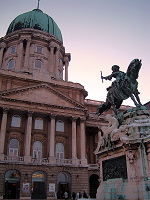
Royal Palace
|
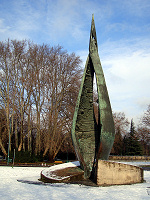
Centennial Memorial
|
|
|
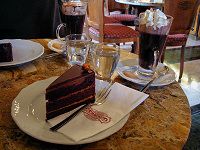
Cake with Hazelnut Hot Chocolate
|

Shoes on the Danube Memorial.
|
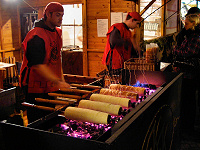
Kürtos Kalács.
|
|
|
When it came
time to explore the Pest side of the river, we began
with a visit to the central market. This massive
iron structure holds three levels of stalls selling
clothing, food, souvenirs, trinkets, and Hungary’s
best known culinary ingredient - paprika. While
paprika comes from dried red peppers, its potency
ranges from edes (sweet) to eros (spicy). We bought
an assortment of types for ourselves and friends. We
eyed the selection of alimentation on display such
as goulash, chicken paprikash, and langos, but J had
her mind set on something sweeter.
Heading up the
pedestrian zoned Vasca Street, past the shops and
restaurants, we arrived at Vörösmarty tér and the
19th century baroque building known for its
delicacies. Inside, the Café Gerbeaud, the décor is
lavish with marble tables, crystal chandeliers, and
velvet curtains. We each ordered a piece of
chocolate cake to accompany our hazelnut hot
chocolate, and braced ourselves for the check.
Slowly nibbling at our treats, we gazed out the
window and watched locals scampering around the
square as they prepared to open the Christmas market
for night. We decided that much like we did in
Luxembourg the year before, we would forgo a
traditional dinner and instead dine on vendor food
at the market.
Although a
smallish Christmas market for such a large European
city, its lack of space was compensated by its
selection of food items. Of course, there are
tempting Christmas staples such as roasted
chestnuts, grilled sausages, steaming goulash, and
rooster testicle stew, but the real stars of the
show are the kürtos kalács. Nicknamed chimney cakes
because of their tubular shape, a long strip of
dough is wrapped around a hollow spit in a long
compact spiral before being rolled in sugar. The
spit is placed over coals and baked right in front
of you while you choose your toppings like cinnamon,
chocolate, nuts, coconut, or you can just have it
natural. One was enough for both of us, and we
peeled off pieces as we strolled around the market
to look at the various stalls.
For our next
full day in Budapest, we were going to need our
bathing suits. We took continental Europe's oldest
subway line to Heroes Square, a massive memorial
centered around the seven leaders of the Magyar
tribes that established the Hungarian presence in
this area. The square lies on the outskirts of
Budapest's sprawling city park. Entering along one
of the main thoroughfares, led us by the stunning
Vajdahunyad Castle which displays a mishmash of
architectural styles to represent several Hungarian
landmarks as a tribute to the 1,000 year celebration
of the Hungarian people. Pushing on, we reached our
final destination, the Szechenyi baths – the largest
thermal bathing complex in Europe. We explored each
room taking dips in the baths of different
temperatures with trips to the sauna and steam rooms
in between. We mustered up the courage to venture
into the freezing temperatures for a soak in the
outdoor pools where despite the thick steam
billowing off the water people were enjoying the
massage pools and playing chess while submerged to
their necks. The sulfate-rich water is famous for
its ability to relieve bone and joint ailments, and
we certainly felt invigorated when we finally
emerged from the baths that evening.
|
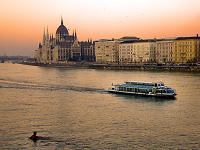
Sunset on the Danube
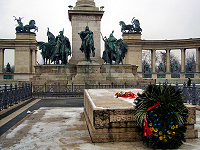
Heroes Square
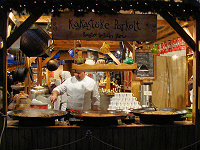
Testicles for sale
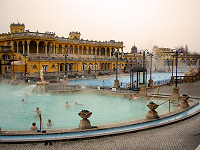
Szechenyi Thermal Baths
|
|
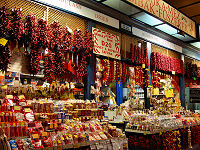
Paprika for sale
|
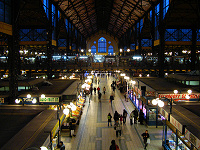
Central Market
|
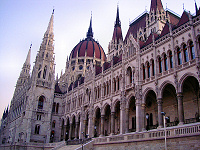
Hungarian Parliament
|
|
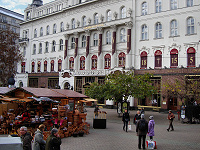
Gerbeaud Café
|
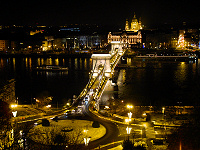
Looking toward Pest from Buda
|
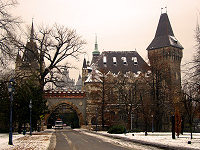
Vajdahunyad Castle
|
|
|
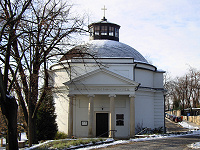
Kerektemplom
|
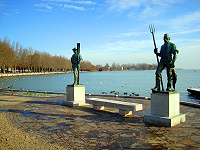
Fisherman and Ferryman
|
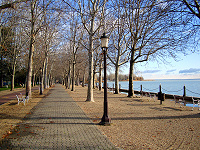
Promenade along Lake Balaton
|
|
|
Though we spent
much of our time traipsing around Budapest, our
hotel was actually located beside Lake Balaton.
Known as the Hungarian Riviera, this 50 mile long
lake is dotted with resort towns and is a major draw
for tourists looking to beat the summer heat by
swimming in its cool waters. As popular as it is
with summer tourists, it is equally as dead in the
winter. We stayed at a historic hotel in
Balatonfüred which was situated right next to the
long lakeside promenade. To say we had the place all
to ourselves would be a slight exaggeration, but we
only saw two other couples during our stay. All of
the lakeside shops and most of the restaurants were
closed for the season, so we had most of our meals
either at the hotel or when we were in Budapest. On
the upside, we had essentially exclusive access to
the spa area of the hotel. Every time we went to use
the steam room, sauna, hot and cold plunge pools, we
did not see another soul. J even managed to talk D
into getting a full body massage - which took less
convincing once he saw the cute blonde masseuses.
On one of the few
days we did not spend in Budapest, we hopped on a
local bus to visit the town of Tihany. This
peninsula that juts out into the lake has the
highest property value of any other area in Hungary,
and the town itself is dominated by the Benedictine
abbey dating from 1055. It was a pleasant place to
spend a half day and to enjoy a nice meal of chicken
paprikash and the local wine.
|
|
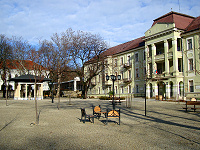
Gyógy Tér
|
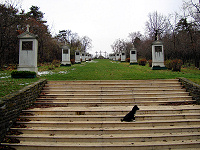
Calvary in Tihany
|
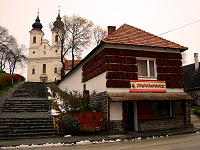
Tihany Abbey
|
|
Copyright © 2005 JnDsTravelog.com. All rights reserved. |
| |